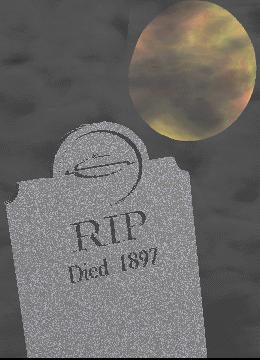UFO Crashes in the 19th
Century
|

Artists
conception of the "Man from Mars" tombstone. (Copyright
Lee Krystek 1996)
|
STRANGE PHENOMENA
------------------------------------------
Startling Find of Some
Dundy County Ranchers
------------------------------------
Long before the famous stories emerged about a UFO
crash in Roswell ,in 1947, tales of
alien spaceships hitting the Earth appeared in 19th Century
papers:
"About 35 miles northwest of Benkelman, Dundy
County, on the 6th of June [1884] a very startling phenomenon
occurred. It seems that John W. Ellis and three of his herdsmen
and a number of other cowboys were out engaged in a round-up.
They were startled by a terrific whirring noise over their heads,
and turning their eyes saw a blazing body falling like a shot
to earth. It struck beyond them, being hidden from view by a
bank."
The article, from the Nebraska Nugget,
goes on to say that the rancher found "fragments of cog-wheels,
and other pieces of machinery" lying on the ground. The heat
was so intense that "as to scorch the grass for a long distance
around each fragment and make it impossible for one to approach..."
The group found the main part of the wreck and one of them "fell
senseless from the gazing at it at too close quarters. His face
was blistered, and his hair singed to a crisp."
"Finding it impossible to approach the mysterious
visitor [the UFO] the party turned back on it's trail. When
it [the UFO] first touched the earth the ground was sandy and
bare of grass. The sand was fused to an unknown depth over a
space about 20 feet wide by 30 feet long, and the melted stuff
was still bubbling and hissing."
Later in the story the ship is described as being
50 to 60 feet long, cylindrical and 10 to 12 feet in diameter.
The writer notes that it was apparently composed of metal with
an appearance like brass, but was remarkably light. The story
also notes that the wreck is located in a remote and wild region
and "the roads are hardly more than trails."
The second story appeared in the Dallas Morning
News on April 19th, 1897:
"About 6 o'clock this morning the early risers
of Aurora were astonished at the sudden appearance of the airship
that had been sailing throughout the country. It was traveling
due north, and much nearer the earth than before."
The article describes how the air vehicle "sailed
over the public square and when it reached the north part of
town collided with the tower of Judge Proctor's windmill and
went to pieces with a terrific explosion, scattering debris
over several acres of ground, wrecking the windmill and water
tank and destroying the judges's flower garden." It continues
with, "The pilot of the ship is supposed to have been the only
aboard, and while his remains are badly disfigured, enough of
the original has been picked up to show he was not an inhabitant
of this world."
"Mr. T. J Weems, the U.S. Signal Service officer
at this place and an authority on astronomy, gives it as his
opinion that he [the pilot] was a native of Mars." According
to the story the remains of the ship were composed of a strange
metal that seemed a mixture of aluminum and silver. The townspeople
came to view the wreak and pick up specimens. The pilot was
buried the day after the article was published.
So what can we make of these crash stories? Was
19th century Earth visited by extra-terrestrial beings with
superior (but apparently faulty) technology?
In viewing any article from 19th century newspapers
we must be aware of the abundance of hoax
journalism during that period. Newspapers didn't just report
news, but also provided entertainment. Much of this was in the
form of books that were serialized of a number of issues. Some
of it was in another form that is little regarded now: The hoax
news story. Both of the above are probably examples of this
almost forgotten tradition. How do we know? Mainly because they
lack any collaborating evidence. In both cases no follow up
stories were ever written which seems strange if events of the
magnitude suggested did really occur. Also no pieces of the
spaceships have ever shown up in local museums or historical
societies.
The Texas incident was investigated in the late
1960's. Then residents of Aurora who were there in 1897 were
still alive. None reported that they remembered the crash. Several
stated that Judge Proctor never had a windmill. One confirmed
that the T. J. Weems mentioned in the story was not a signal
officer, but the town blacksmith. Most were of the opinion that
F. E. Hayden, who had written the story, was just trying to
get some publicity for the town. In addition, a search of the
alleged crash site with a metal detector revealed nothing.
The story might have remained dead except for
a writer with the Dallas Times Herald. In 1973 the newspaper
did a series of sensational stories about the "crash." Despite
faulty evidence and questionable witness accounts the stories
managed to attract national attention. The excitement reached
its peak when an Aurora cemetery was desecrated. The cemetery
had kept meticulous records showing just who was buried where
and there was no "man from mars" on the roster. Despite this,
a plot, that some claimed was the Martian's, was dug up and
the tombstone stolen. According to some accounts the tombstone
had a picture of an UFO carved into it.

Copyright Lee Krystek 1996.
All Rights Reserved.